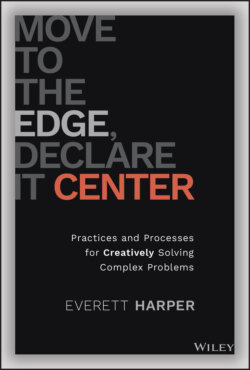Читать книгу Move to the Edge, Declare it Center - Everett Harper - Страница 15
Case Study: Introducing Salary Transparency
ОглавлениеImagine your first day at work, and your business card looks like this:
What would you think? Might you wonder, “Does everybody have their salaries displayed on their business card?” Might you look around and ask yourself, “How do I compare with the other directors?” I suspect you are definitely thinking, “Why on earth would a company do this?”
While we don't have our salaries on our business cards, we did make all salaries transparent in 2017. Why? We wanted to solve a complex problem: racial and gender inequality in compensation. In most labor markets, BIPOC13 people and people who identify with she/her pronouns get paid less than White men for the same job. It is an old, persistent problem, but we treated it as an obstacle we needed to overcome in order to build the diverse, inclusive company we wanted. There weren't many companies to emulate, and we couldn't find any that were doing it explicitly for diversity, equity, and inclusion (DEI) purposes. We were on the edge.
Truss was founded with 67 percent “underrepresented minorities.”14 Our founding team of me – a Black male CEO – and a technical leadership team of a White woman COO and White male CTO was absolutely contrary to the Silicon Valley startup narrative in 2011. Despite degrees from Duke, Stanford, University of California (UC)–Santa Cruz and UC–Berkeley, recognized engineering expertise in pioneering technical practices, and brand recognition from a “hot” company, we were the “anti‐pattern.” The desirable startup teams in 2011 were young, White, male engineers from prestige programs. We were definitely outsiders … and that gave us an important insight. From our vantage point, we could see the flaws in the assumed benefit of homogeneous teams, and we could access networks of knowledge and talent that were ignored by the mainstream of Silicon Valley.15 That didn't guarantee success, however – we had to turn our advantage into a sustainable company.
Our Move to the Edge started with several hypotheses:
Building a diverse company is a long series of investments resulting in a network of trust.
Diverse teams outperform nondiverse teams, especially around innovation, decision‐making, and accounting for risks.
Diversity and inclusion initiatives must be central to the core operating model of the company. DEI initiatives that are only marketing or human resource initiatives will fail.
There are skilled, motivated, and high‐integrity people from diverse backgrounds who live outside the San Francisco Bay area.
Those were our beliefs – now we had to test them with data. I started writing articles on using networks to find diverse candidates, in order to attract like‐minded employees. I found research from academics like Dr. Kathy Williams,16 demonstrating that companies with diverse boards and executive teams outperform nondiverse ones on a variety of metrics, including stock price valuation on the public markets.17 We built a network of relationships by attending dozens of events, meetups, and gatherings focused on diversity and inclusion, and learned how we could help one another. I joined a new group called Black Founders and helped start the N.O.D., a social gathering for Black men in tech, finance, and legal fields.
Each of these actions was small, but we followed a principle of improving by marginal gains. We gained insights that validated or invalidated these hypotheses. Over time, we felt more equipped to place bigger bets and make bigger commitments. In 2016, we joined the first startup cohort of Project Include, a data‐driven DEI initiative anchored at the Kapor Center.18 We validated that DEI initiatives weren't successful as just HR or marketing initiatives. We sharpened our perspective, learning that the best results come when the CEO is directly involved, either hands‐on or as an executive sponsor. Cultural change requires the CEO to set, model, and reinforce purpose and accountability.
Finally, there was the well‐documented, cross‐industry data on pay disparities. We surmised that if there is a pay disparity between a Black woman and a White man hired on the same day for the same job, they could perform equally well, earn the same percentage salary increase, yet in five years, have a substantial difference in their compensation. How long do you think that high‐performing Black woman will remain at your company after she finds out that she is being paid less for the same job? We saw that even well‐intentioned companies fell into that trap. If we wanted to attract and retain people from diverse backgrounds at Truss, we believed salary transparency was a concrete initiative to address this complex problem.
But we didn't know the answer, so we started on the journey using what became the framework for Move to the Edge, Declare It Center. I'll return to the specific methods in the Salary Transparency Case Study in Chapter 2. However, it is time to examine the ways we can make poor decisions around complex problems, despite our best intentions.
